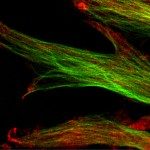Lien vers Pubmed [PMID] – 22114320
RNA 2012 Jan;18(1):155-65
Processive RNases are unable to degrade efficiently very short oligonucleotides, and they are complemented by specific enzymes, nanoRNases, that assist in this process. We previously identified NrnA (YtqI) from Bacillus subtilis as a bifunctional protein with the ability to degrade nanoRNA (RNA oligos ≤5 nucleotides) and to dephosphorylate 3′-phosphoadenosine 5′-phosphate (pAp) to AMP. While the former activity is analogous to that of oligoribonuclease (Orn) from Escherichia coli, the latter corresponds to CysQ. NrnA homologs are widely present in bacterial and archaeal genomes. They are found preferably in genomes that lack Orn or CysQ homologs. Here, we characterize NrnA homologs from important human pathogens, Mpn140 from Mycoplasma pneumoniae, and Rv2837c from Mycobacterium tuberculosis. Like NrnA, these enzymes degrade nanoRNA and dephosphorylate pAp in vitro. However, they show dissimilar preferences for specific nanoRNA substrate lengths. Whereas NrnA prefers RNA 3-mers with a 10-fold higher specific activity compared to 5-mers, Rv2837c shows a preference for nanoRNA of a different length, namely, 2-mers. Mpn140 degrades Cy5-labeled nanoRNA substrates in vitro with activities varying within one order of magnitude as follows: 5-mer>4-mer>3-mer>2-mer. In agreement with these in vitro activities, both Rv2837c and Mpn140 can complement the lack of their functional counterparts in E. coli: CysQ and Orn. The NrnA homolog from Streptococcus mutans, SMU.1297, was previously shown to hydrolyze pAp and to complement an E. coli cysQ mutant. Here, we show that SMU.1297 can complement an E. coli orn(-) mutant, suggesting that having both pAp-phosphatase and nanoRNase activity is a common feature of NrnA homologs.

